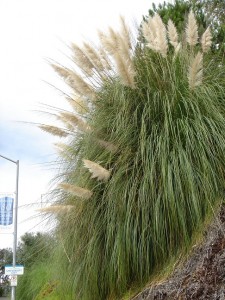 Invasive Plants Cause Problems in Rose Canyon
Invasive Plants Cause Problems in Rose Canyon
By Kelly Makley, Rose Creek Watershed Coordinator
Did you know that weeds are a significant threat to Rose Canyon? According to the organization PlantRight, the control of invasive species costs California $85 million every year. These plants, such as pampas grass, have “escaped” from landscaped areas and invade our natural spaces.
Invasive plants create fire hazards and crowd the native plants that provide homes for wildlife. They also lead to flooding, landslides and poor water quality. In some areas, invasive plants are so dense that they have created hiding places for people engaged in illegal activities. Their seeds move in the wind and water, making them difficult to control unless a comprehensive approach is taken.
Fortunately, a local organization, the Chaparral Lands Conservancy, has received a grant to conduct an Invasive Plant Control Project throughout Rose and San Clemente Canyons starting in October 2012. The methods and products that will be used by licensed contractors have been approved by agencies that protect California’s wildlife.
Here’s how YOU can help prevent invasive plants from spreading:
– Survey your property and remove any invasive plants.
– Plant native or non-invasive plants. The Don’t Plant a Pest brochure (available at www.calipc.org/landscaping/dpp/pdf/SoCalPrintable.pdf) recommends many beautiful alternatives that can even save you money because they require less water and fertilizer.
– Remove any new sprouts before they become a problem.
This project is part of a comprehensive effort to enhance the Rose Creek Watershed, which includes both Rose and San Clemente creeks which drain into Mission Bay. You can learn more about this project at www.rosecreekwatershed.org or www.facebook.com/rosecreekwatershed.

